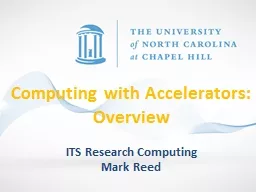PPT-Protecting Host Systems from Imperfect Hardware Accelerators
Author : tawny-fly | Published Date : 2018-02-26
Lena E Olson PhD Final Defense August 17 th 2016 2 Accelerators are increasingly popular Good for performance energyefficiency programmability exciting new applications
Presentation Embed Code
Download Presentation
Download Presentation The PPT/PDF document "Protecting Host Systems from Imperfect H..." is the property of its rightful owner. Permission is granted to download and print the materials on this website for personal, non-commercial use only, and to display it on your personal computer provided you do not modify the materials and that you retain all copyright notices contained in the materials. By downloading content from our website, you accept the terms of this agreement.
Protecting Host Systems from Imperfect Hardware Accelerators: Transcript
Download Rules Of Document
"Protecting Host Systems from Imperfect Hardware Accelerators"The content belongs to its owner. You may download and print it for personal use, without modification, and keep all copyright notices. By downloading, you agree to these terms.
Related Documents














